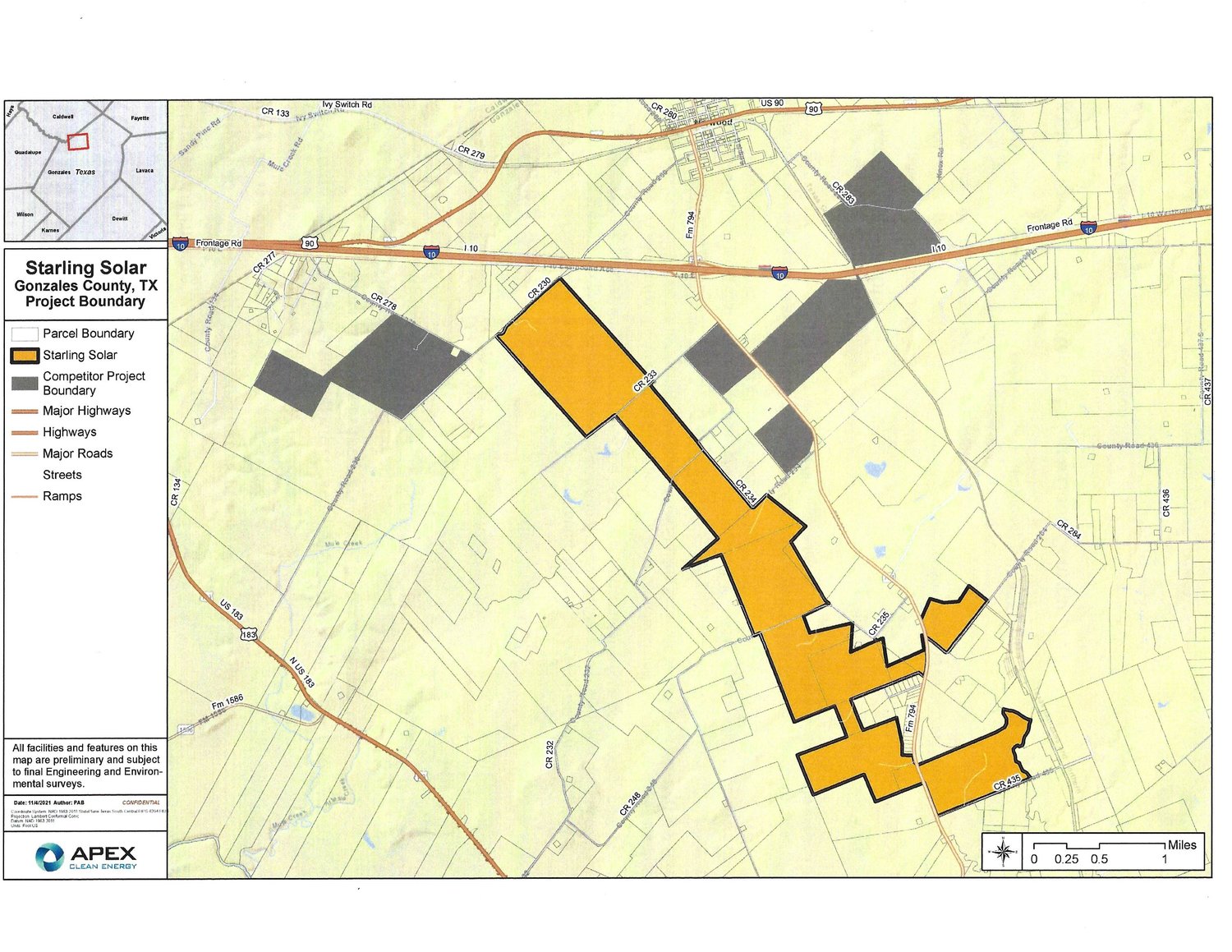Commissioners table decision on Starling Solar abatement
The Gonzales County Commissioners Court decided Monday, Nov. 8, to table a decision on designating a 2,753-acre area near Harwood Road as a tax abatement reinvestment zone for Starling Solar LLC.
Starling Solar, a division of Apex Clean Energy out of Charlottesville, Virginia, is looking to build a 1,400-acre,120-megawatt alternating current photovoltaic generation facility — commonly known as a “solar farm” — with a total investment expected to exceed $138 million.
Representatives with Apex Clean Energy who were present for Monday’s meeting said the Starling Solar LLC project is expected to generate enough energy to power more than 28,000 homes per year, using access to existing transmission lines on private land and would deliver power into the Electric Reliability Council of Texas (ERCOT) state electrical grid.
The facility would also create part-time and full-time jobs during construction and operation of the solar farm.
The company is seeking separate 10-year tax abatements, known as 312 and 313 agreements, from Gonzales County and Gonzales ISD that would cap the taxable value of the property.
A company may receive a tax abatement agreement if it would contribute to the retention or expansion of primary employment or would attract major investment in the zone that would be a benefit to the property and would contribute to the economic development of the county, which is what Apex officials are saying the Starling project will do.
Competing companies already own several projects near the proposed site, which is mostly west of Harwood Road (Farm-to-Market Road 794) just south of Interstate 10.
After hearing concerns about the proximity of the solar panels to neighboring homes, Courtney McReynolds, development manager for Apex Clean Energy, said the company could look at improving the buffer zone between the solar farm and nearby residents.
“We certainly want to be a part of the community and we don’t want to have anyone upset and I can completely understand why you may be upset at this project,” McReynolds said. “We would be happy to look again at the buffer zone to see what can be done to make it something we can all live with.”
However, John Stetson, who owns property on Oak Creek Drive, told McPherson the project is going to hurt the value of his land — especially the aesthetic value — if it only has a view of solar panels.
“Build the thing, but just don’t destroy my life while you’re doing it!” Stetson told McReynolds. “One of the reasons we put my house where it is is because we have that view. We have that view of (A.P) Breitschopf’s property out there and it is classic. That’s a million-dollar view out there and where am I going to find that again?
“This is just a nightmare. My wife and I spent 18 years working on this to where it is a beautiful place and if you cover it up with solar panels, it’s worthless!”
Stetson told the Inquirer the nearby Texas and Gonzales Northern Railroad and VISTA sand facility have already forced property owners to “take a hit” and that “it’s not just my place. The whole subdivision will become worthless.
“All of the people across the front (in Oak Creek subdivision), they’re stuck because who is going to buy their property with a railyard across the highway from them?” Stetson said.
Commissioners actually voted to approve the 312 agreement (named for the section of the Texas Tax Code which authorizes it) prior to Stetson addressing his concerns and then, after asking McReynolds about the possibility of fixing buffer zone issues, rescinded their vote and agreed to table a decision until their Nov. 22 meeting.
If the abatement is granted, the project is expected to begin construction as early as 2022 and be completed and fully operational in fall 2023.
The U.S. Energy Information Administration (EIA) predicts Texas will add 10 gigawatts (Gw) of utility-scale solar capacity statewide by the end of 2022, bringing the total installed solar capacity to 14.9 Gw. In 2020, solar energy represented just four percent of all generating capacity in the state and just two percent of in-state electricity generation, compared to 53 percent and 52 percent for natural gas and 23 percent and 20 percent for wind.
Comments







